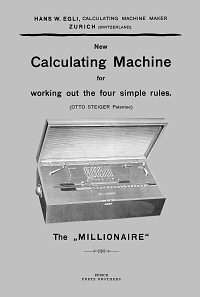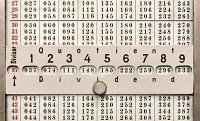

The Millionaire was supplied with an instruction booklet of 24 pages (150 x 230mm) containing an illustration and description of the controls, procedures for addition, subtraction, multiplication, and division, and examples of calculations involving proportions, interest, squares, and square roots. A shorter version of the ASMD instructions was printed on a card attached to the inside of the lid.
These notes summarise the basic operations.
The internal processes involved in multiplication have been described in detail in the preceeding sections. From the operator's perspective, the process is very simple.
The machine is first cleared, the carriage is returned to the right-hand side, and the Regulator is set to M. The first factor (the multiplicand) is set on the sliders or keyboard. The multiplier lever is set to the first (most significant) digit of the second factor and the crank is given one full turn clockwise. The set-and-turn procedure is repeated for the remaining digits. At the end of the process all three components are visible for verification - the multiplicand in the setting mechanism, the multiplier in the counter register, and the result in the accumulator.
To perform an addition on a multiplying machine, the carriage is held stationary while the entry is multiplied by 1. The partial product is the same as the original entry, which is added to the accumulator.
The operator must clear the machine, return the carriage to the right-hand side, set the Regulator to A, and set the multiplier to 1. Numbers entered on the setting mechanism are added to the accumulator by turning the crank. The carriage does not move, and the counter mechanism does not operate.
Internally, setting the Regulator to A disconnects the carriage shift driving dog so that the carriage will remain stationary. With the multiplier set to 1, there will be no movement of the racks on the tens cycle. On the units cycle, the value in the setting mechanism will be multiplied by 1 and added to the accumulator.
The motor-driven machine has a lever (at the rear of the multiplier panel) which locks the multiplier lever at 1 and engages the automatic keyboard clearing mechanism at the end of each cycle.
Subtraction is the same as addition, except that the differentials drive the register in the opposite direction.
If the initial value for a subtraction is not already present in the accumulator (as a result of a previous calculation), it can be entered manually using the twirler knobs.
Division is performed by the usual method of repeated subtraction, but with the advantage that multiple subtractions can be performed in a single operation.
The carriage is first cleared and returned to the right, and the Regulator is set to D. The dividend is set in the accumulator using the twirlers, starting one place in from the left-hand end (to allow for the automatic carriage shift). The divisor is set at the left-hand side of the sliders or keyboard.
The operator estimates the number of times the divisor can be subtracted from the dividend by comparing the initial digits of each, then sets the multiplier lever to the estimate and turns the crank. At the completion of the cycle, the number set on the multiplier lever appears in the counter as the first digit of the quotient, the product of the quotient digit and the divisor has been subtracted from the accumulator, and the carriage has been moved one place to the left. The process is repeated until sufficient digits have been obtained.
The efficiency of division on the Millionaire depends on the skill of the operator in estimating the quotient digits, as much time can be lost in correcting a poor estimate.
If the estimate is too high, an overdraft will occur and the bell will ring. In order to cancel the excess subtraction, the operator must change the Regulator to Addition, set the multiplier to 1, turn the crank until the overdraft is cleared, then change the Regulator back to Division and continue on.
If the estimate is too low, there is no warning bell. In preparing the next estimate, the operator must be alert to observe that the divisor is greater than the dividend, and then follow a similar process to perform an extra subtraction.

As an aid to less skilled operators, a chart of 1-to-9 times 1-to-99 is fastened inside the lid of the machine, with a pair of sliding metal cursors and a set of instructions for a purely "mechanical" method of estimation. It is still possible for occasional errors to be made due to differences in the third places.
The instruction manual points out that the Millionaire can always be operated in the same manner as other "arithmometers Thomas, Tate, Burkhardt, Brunsviga, etc", with repeated additions or subtractions and manual carriage shifts.